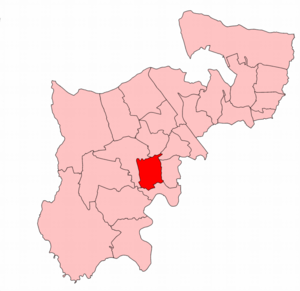Ealing East (UK Parliament constituency) facts for kids
Quick facts for kids {{{Name}}}[[{{{Type}}} constituency]] |
|
|---|---|
| [[Image:{{{Map1}}}Constituency.svg|120px|]] [[Image:England{{{Map2}}}.svg|120px|]] |
|
| {{{Name}}} shown within [[{{{Entity}}}]], and {{{Entity}}} shown within England | |
| Created: | {{{Year}}} |
| MP: | {{{MP}}} |
| Party: | {{{Party}}} |
| Type: | House of Commons |
| County: | [[{{{County}}}]] |
| EP constituency: | [[{{{EP}}} (European Parliament constituency)|{{{EP}}}]] |
Ealing East was a special area in Middlesex, England, that had its own representative in the UK Parliament. It was one of a few areas that made up the Municipal Borough of Ealing between 1945 and 1950. This area included the main town centre of Ealing. After 1950, its boundaries changed, and it became part of west London in 1965.
People living in Ealing East got to choose one person, called a Member of Parliament (MP), to speak for them in the House of Commons. This is the main part of the UK Parliament. They used a voting system called "first past the post". This means the candidate with the most votes wins.
Ealing East only had one election, which was the general election in 1945. This election was a big win for the Labour Party, led by Clement Attlee. However, the person who won in Ealing East was Frank Sanderson, a Conservative. He had already represented the area before it was called Ealing East.
Contents
A Look at Its History
The Ealing East area was created for the 1945 general election. This was a big election that happened right after World War II. It was then removed as a separate area for the 1950 general election.
After 1950, the Municipal Borough of Ealing was split into new areas. These new areas were called Ealing North and Ealing South. However, one small part of Ealing, called Hanwell, stayed in the Southall area, which was to the west. Southall was also created in 1945.
Where Was Ealing East?
The Ealing East area was made up of six smaller parts of the Municipal Borough of Ealing. These smaller parts were called wards. They were: Castlebar, Drayton, Grange Grosvenor, Lammas, Manor, and Mount Park. These names helped define the exact boundaries of the Ealing East area.
Who Represented Ealing East?
Only one person represented Ealing East in Parliament during its short existence.
| Election | Member | Party | |
|---|---|---|---|
| 1945 | Sir Frank Sanderson, Bt. | Conservative | |
| 1950 | This area was changed. See Ealing South for new areas. | ||
How Did the Election Go?
The only election for Ealing East happened in 1945. Here's how the votes turned out:
The 1945 Election Results
| General election 1945: Ealing East | |||||
|---|---|---|---|---|---|
| Party | Candidate | Votes | % | ±% | |
| Conservative | Frank Sanderson | 22,916 | 47.83 | ||
| Labour | David John Johnston | 18,619 | 38.86 | ||
| Liberal | Harold William Foster | 6,377 | 13.31 | ||
| Majority | 4,297 | 8.97 | |||
| Turnout | 47,912 | 73.16 | |||
| Conservative win (new seat) | |||||
This shows that Frank Sanderson from the Conservative Party won the election. He received the most votes. The "majority" means how many more votes he got than the person in second place. The "turnout" shows what percentage of people who could vote actually did vote.
For information about elections after 1950 in this area, you would look at the results for Ealing South.


